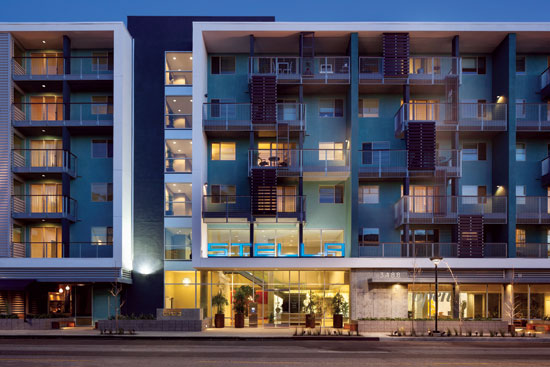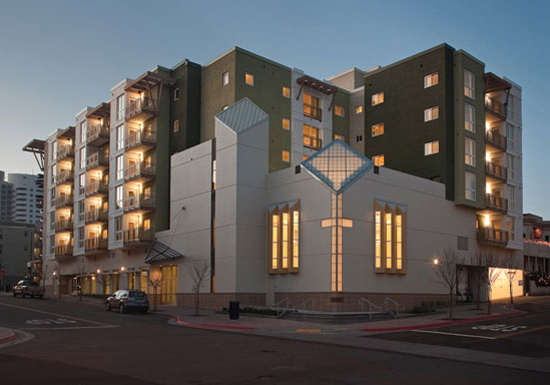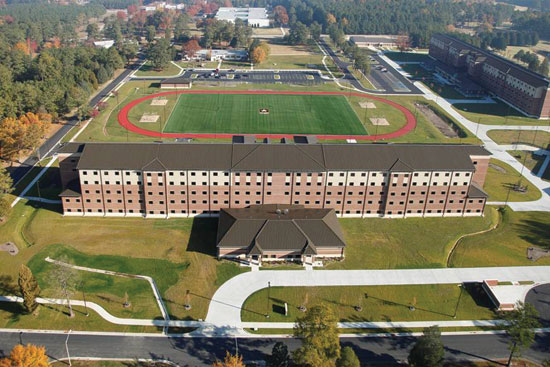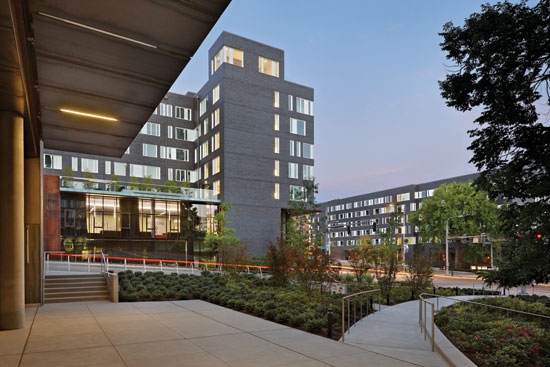This CE Center article is no longer eligible for receiving credits.
Building Code Requirements
The IBC is the predominant U.S. model building code, having been adopted by most states with or without amendments. Chapters 16, 17 and 23 cover structural wood design and construction. (Non-structural provisions such as heights and areas are covered elsewhere.) The IBC classifies buildings into five types of construction. Construction Types I and II are generally limited to non-combustible materials such as concrete and steel, although wood can be used in all types of construction to varying degrees. Type III allows a mix of non-combustible and combustible materials, while construction Types IV and V can have combustible building materials.
Multi-story wood construction generally falls under Types III and V. (However, Type IV multi-story construction, also known as Heavy Timber, is growing in interest.) Each building type is further subdivided into A and B, which have different fire-resistance rating requirements, with A being the more rigorous. (See section: Fire Protection Requirements.) “From a cost perspective it makes no sense to use Type I for five stories,” says Tim Smith, AIA, founding principal of Togawa Smith Martin, Inc., Los Angeles, and a pioneer of five-story wood framing in California. “Type I is more realistic for taller buildings. Type III for wood construction helps fill the gap between low-rise and taller buildings.”
Permissible Increases in Area and Height
Table 503 of the IBC lists allowable building heights and floor areas for different construction types; however, there are provisions for increases. For Type IIIA, for instance, an allowable floor area of 24,000 square feet as stipulated in Table 503 for Group R-2 occupancies could be increased to 90,000 square feet per story. Such provisions include:
Open front areas. IBC Section 506.2 permits area increases up to 75 percent for buildings with open spaces around their perimeters such as yards, courts, parking areas and streets, which provide fire-fighting access.
Sprinkler systems. For most occupancy groups, increases to the allowable height (and number of stories) and floor area are permitted according to IBC Section 504.2 with the use of an approved automatic sprinkler system in accordance with the National Fire Protection Association (NFPA) 13 standard.
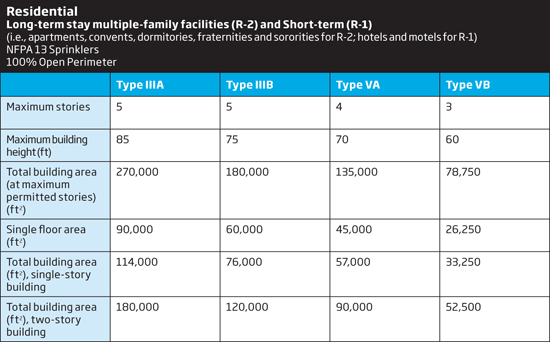
Source: American Wood Council
IBC allowable heights and areas for residential wood construction
“Type IIIA construction for Residential Group R is allowed to be four stories and 65 feet high while a Type VA building is permitted to be three stories and 50 feet,” explains Kevin Cheung, Ph.D., P.E., chief engineer for the Western Wood Products Association. “However, when protected by automatic sprinklers, Type IIIA and Type VA buildings are allowed to be five and four stories, respectively. Type IIIA is permitted an increase in height to 85 feet and Type VA an increase to 70 feet.” (See Table of IBC Allowable Heights and Areas for Residential Construction.)
In the Pacific Northwest (Washington, Oregon and Idaho), the model code has been amended to allow Type V residential buildings to have up to five stories of wood-frame construction with additional limitations. In Canada, the British Columbia building code was revised in 2009 to permit residential wood construction up to six stories.
Use of fire walls to “separate” buildings. While the code does not explicitly require fire walls, they may be utilized in many cases to expand the prescribed size of a building. (See Parkside sidebar on page 4.) IBC Section 706.4 requires a three-hour rating for R-2 (long-term residential) occupancy of Type IIIA construction.
IBC Section 706 permits portions of a building separated by one or more fire walls to be considered as separate, side-by-side buildings. In this way, wood-frame buildings can be designed as separate but connected buildings for code-compliance purposes. This partitioning allows wood buildings to be unlimited in size.
Mezzanines. IBC Section 505 excludes mezzanines from the determination of number of stories or building area. Mezzanines may be one-third of the floor area of the room or space beneath. For example, a loft or penthouse plus a mezzanine on the first concrete podium floor could add two “stories” to the building.
Podium design. In order to gain an additional story for multi-level wood-framed buildings, architects and engineers are increasingly turning to podium or pedestal design rather than building directly on a concrete slab on grade. Section 510.2 of the 2012 IBC allows five- or six-story wood-frame structures over one level of typically concrete Type IA construction. These “five-over-one” and “six-over-one” buildings are treated in the code as two structures separated by a three-hour fire-resistance-rated horizontal assembly. The podium is considered as a separate and distinct building for the purpose of determining height and area limitations and vertical continuity of fire walls. The overall height of the two buildings together is measured from grade plane, and the height limitations of Chapter 5 apply. The 2015 IBC will expand this opportunity by allowing two or more stories below the three-hour horizontal fire assembly with the caveat that the overall building height from grade still not exceed the limits set out in Chapter 5.
Cost-effective, code-compliant and sustainable, mid-rise wood construction is gaining the attention of design professionals nationwide, who see it as a way to achieve higher density housing at lower cost—while reducing the carbon footprint of their projects. Yet, many familiar with wood construction for two- to four-story residential structures are not aware that the International Building Code (IBC) allows wood-frame construction for five stories and more in building occupancies that range from business and mercantile to multi-family, military, senior, student and affordable housing.
“Once designers know that wood offers all the required safety and structural performance capabilities and meets code requirements for mid-rise, the most appealing feature of wood tends to be its price,” says Michelle Kam-Biron, P.E., S.E., director of education for the American Wood Council. “Multi-family housing was one of the first market segments to rebound from the recession—because it's more affordable than single-family housing while offering advantages such as less upkeep and, in most cases, closer proximity to amenities. Wood construction is attractive for multi-family projects because it offers a high percentage of rentable square footage at a relatively low cost, but its benefits are equally applicable to other occupancy types.”
Among their benefits, wood buildings typically offer faster construction and reduced installation costs. For example, after completing the first phase of a developer-funded five-story student housing project using steel construction, OKW Architects in Chicago switched to wood. “The 12-gauge steel panels were expensive, very heavy and difficult to install; and welding and screwing the shear strap bracing was very time consuming,” says project architect Eileen Schoeb. “Using wood was far more economical for the second phase.” Farooq Maniar, president of California-based Farooq Maniar, Inc. and structural engineer for a number of senior apartment projects also finds wood construction less costly. “The lead time and construction time are far less than they are for steel.”
Wood construction also offers advantages for project teams seeking green building certification or simply to reduce the environmental impact of their buildings. Wood grows naturally and is renewable, and life cycle assessment studies consistently show that wood offers environmental advantages in terms of embodied energy, air and water pollution, and other impact indicators.1
From a carbon footprint perspective, wood continues to store carbon absorbed during the tree's growing cycle, keeping it out of the atmosphere for the lifetime of the building—or longer if the wood is reclaimed at the end of the building's service life and reused or manufactured into other products. The manufacturing of wood products also results in less greenhouse gas emissions than other materials.2 For example, according to one online carbon calculator,3 the new Stella apartment complex, which includes one four-story wood-frame building and one five-story wood-frame building on a shared concrete podium, has a carbon benefit equivalent to 14,049 metric tons of CO2. This includes 4,495 metric tons of CO2 stored in the wood products and 9,554 metric tons of avoided CO2 emissions. According to the U.S. Environmental Protection Agency's Greenhouse Gas Equivalencies Calculator, this equates to emissions from 2,683 cars for a year or from the energy required to operate an average home for 1,194 years.4
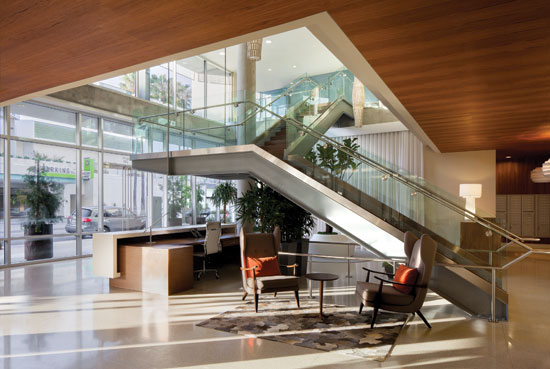
Photo: Lawrence Anderson, www.lawrenceanderson.net
Interior of Stella, a contemporary apartment building in Marina del Rey, California.
“Wood is also versatile and adaptable,” says Kam-Biron. “Modifications on the jobsite tend to be straightforward and are easily made.” A survey of 227 buildings demolished in Minneapolis/St. Paul found that buildings are often torn down within 50 years, regardless of material, because of changing needs and increasing land values as opposed to performance issues.5 Overall, wood buildings in the study had the longest life spans, showing that wood structural systems are fully capable of meeting a building's longevity expectations. However, when you consider the embodied energy in demolished buildings and the implications of material disposal, the fact that wood is adaptable—either through renovation or deconstruction and reuse (with minimal additional processing)—is a significant advantage.
Mastering Wood Construction Design
As with any other type of construction, mastering the technical details of wood-frame construction is critical to creating cost-effective buildings that are safe and durable. Building codes require all building systems to perform to the same level of safety, regardless of material used, and wood-frame structures can be designed to meet or exceed standards for (among other things) fire protection, seismic performance and resistance to high winds.
The following pages will provide an overview of technical considerations related to the design, safety and structural performance of mid-rise wood buildings, as well as two trends that are expanding the opportunities for wood use in multi-story design.
Building Code Requirements
The IBC is the predominant U.S. model building code, having been adopted by most states with or without amendments. Chapters 16, 17 and 23 cover structural wood design and construction. (Non-structural provisions such as heights and areas are covered elsewhere.) The IBC classifies buildings into five types of construction. Construction Types I and II are generally limited to non-combustible materials such as concrete and steel, although wood can be used in all types of construction to varying degrees. Type III allows a mix of non-combustible and combustible materials, while construction Types IV and V can have combustible building materials.
Multi-story wood construction generally falls under Types III and V. (However, Type IV multi-story construction, also known as Heavy Timber, is growing in interest.) Each building type is further subdivided into A and B, which have different fire-resistance rating requirements, with A being the more rigorous. (See section: Fire Protection Requirements.) “From a cost perspective it makes no sense to use Type I for five stories,” says Tim Smith, AIA, founding principal of Togawa Smith Martin, Inc., Los Angeles, and a pioneer of five-story wood framing in California. “Type I is more realistic for taller buildings. Type III for wood construction helps fill the gap between low-rise and taller buildings.”
Permissible Increases in Area and Height
Table 503 of the IBC lists allowable building heights and floor areas for different construction types; however, there are provisions for increases. For Type IIIA, for instance, an allowable floor area of 24,000 square feet as stipulated in Table 503 for Group R-2 occupancies could be increased to 90,000 square feet per story. Such provisions include:
Open front areas. IBC Section 506.2 permits area increases up to 75 percent for buildings with open spaces around their perimeters such as yards, courts, parking areas and streets, which provide fire-fighting access.
Sprinkler systems. For most occupancy groups, increases to the allowable height (and number of stories) and floor area are permitted according to IBC Section 504.2 with the use of an approved automatic sprinkler system in accordance with the National Fire Protection Association (NFPA) 13 standard.

Source: American Wood Council
IBC allowable heights and areas for residential wood construction
“Type IIIA construction for Residential Group R is allowed to be four stories and 65 feet high while a Type VA building is permitted to be three stories and 50 feet,” explains Kevin Cheung, Ph.D., P.E., chief engineer for the Western Wood Products Association. “However, when protected by automatic sprinklers, Type IIIA and Type VA buildings are allowed to be five and four stories, respectively. Type IIIA is permitted an increase in height to 85 feet and Type VA an increase to 70 feet.” (See Table of IBC Allowable Heights and Areas for Residential Construction.)
In the Pacific Northwest (Washington, Oregon and Idaho), the model code has been amended to allow Type V residential buildings to have up to five stories of wood-frame construction with additional limitations. In Canada, the British Columbia building code was revised in 2009 to permit residential wood construction up to six stories.
Use of fire walls to “separate” buildings. While the code does not explicitly require fire walls, they may be utilized in many cases to expand the prescribed size of a building. (See Parkside sidebar on page 4.) IBC Section 706.4 requires a three-hour rating for R-2 (long-term residential) occupancy of Type IIIA construction.
IBC Section 706 permits portions of a building separated by one or more fire walls to be considered as separate, side-by-side buildings. In this way, wood-frame buildings can be designed as separate but connected buildings for code-compliance purposes. This partitioning allows wood buildings to be unlimited in size.
Mezzanines. IBC Section 505 excludes mezzanines from the determination of number of stories or building area. Mezzanines may be one-third of the floor area of the room or space beneath. For example, a loft or penthouse plus a mezzanine on the first concrete podium floor could add two “stories” to the building.
Podium design. In order to gain an additional story for multi-level wood-framed buildings, architects and engineers are increasingly turning to podium or pedestal design rather than building directly on a concrete slab on grade. Section 510.2 of the 2012 IBC allows five- or six-story wood-frame structures over one level of typically concrete Type IA construction. These “five-over-one” and “six-over-one” buildings are treated in the code as two structures separated by a three-hour fire-resistance-rated horizontal assembly. The podium is considered as a separate and distinct building for the purpose of determining height and area limitations and vertical continuity of fire walls. The overall height of the two buildings together is measured from grade plane, and the height limitations of Chapter 5 apply. The 2015 IBC will expand this opportunity by allowing two or more stories below the three-hour horizontal fire assembly with the caveat that the overall building height from grade still not exceed the limits set out in Chapter 5.
Fire Protection Requirements
Fire-resistance rating requirements for building elements are provided in IBC Table 601. Chapter 7 of the IBC covers materials and assemblies used for fire-resistance-rated construction and separation of adjacent spaces.
Wood-frame building elements that require fire resistance are required to have the fire-resistance rating be determined in accordance with the test procedures set forth in ASTM E119, Standard Test Methods for Fire Tests of Building Construction Material. The code also provides alternative methods for determining fire resistance per IBC Section 703.3, which includes prescription tables in 720 or calculations for fire resistance in 721.
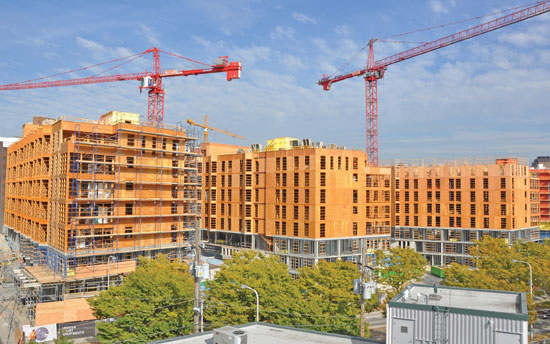
Photo: W.G. Clark Construction, Ankrom Moisan Architects
Mercer Court at the University of Washington includes five buildings, each with five stories of wood-frame construction over two or three stories of concrete.
Fire-Resistance Assemblies
One-hour and two-hour fire-resistance requirements are generally provided by fire-rated assemblies that include gypsum sheathing.
Lists of accepted rated wood floor and wall assemblies are available from the American Wood Council (DCA 3: Fire-Rated Wood-Frame Wall and Floor/Ceiling Assemblies, www.awc.org) and APA (Form W305, www.apawood.org).
Other sources are (UL) Fire-resistance-rated Systems and Products, the UL Fire Resistance Directory, and the Gypsum Association's Fire Resistance Design Manual.
Fire-Retardant-Treated Wood (FRT)
The building code (IBC Section 2303.2) permits exterior two-hour rated bearing walls in Type III construction to be constructed of fire-retardant-treated (FRT) wood, an acceptable substitute for a non-combustible material.
Fire Protection Requirements
Fire-resistance rating requirements for building elements are provided in IBC Table 601. Chapter 7 of the IBC covers materials and assemblies used for fire-resistance-rated construction and separation of adjacent spaces.
Wood-frame building elements that require fire resistance are required to have the fire-resistance rating be determined in accordance with the test procedures set forth in ASTM E119, Standard Test Methods for Fire Tests of Building Construction Material. The code also provides alternative methods for determining fire resistance per IBC Section 703.3, which includes prescription tables in 720 or calculations for fire resistance in 721.
Fire-Resistance Assemblies
One-hour and two-hour fire-resistance requirements are generally provided by fire-rated assemblies that include gypsum sheathing.
Lists of accepted rated wood floor and wall assemblies are available from the American Wood Council (DCA 3: Fire-Rated Wood-Frame Wall and Floor/Ceiling Assemblies, www.awc.org) and APA (Form W305, www.apawood.org).
Other sources are (UL) Fire-resistance-rated Systems and Products, the UL Fire Resistance Directory, and the Gypsum Association's Fire Resistance Design Manual.
Fire-Retardant-Treated Wood (FRT)
The building code (IBC Section 2303.2) permits exterior two-hour rated bearing walls in Type III construction to be constructed of fire-retardant-treated (FRT) wood, an acceptable substitute for a non-combustible material.
Designing for Different Fire Ratings
One framing consideration for Type IIIA is that floors and walls may have different fire ratings. Since load bearing exterior walls are required to have a two-hour rating, the intersection of a one-hour floor requires detailing. This can be accomplished by allowing the wall studs with one layer of gypsum to extend to the underside of the floor sheathing, and supporting the floor framing off the top plates with the use of a hanger designed to span over a layer of gypsum sheathing. Another framing option is to hang the floor framing off a 2x ledger, which provides as much if not more fire resistance as the layer of gypsum. The one-hour wall rating plus the one-hour floor system yields the required two-hour rating.

*Source: IBC Table 601, **IBC Table 706.4
Fire-resistance requirements for Type IIIA and Type VA construction
Fire Walls
Fire walls are not required by the building code; however, they may be utilized to increase the square footage of a building. For R1 (short term residential) and R-2 Type IIIA structures, the IBC requires a non-combustible three-hour fire-resistant wall between buildings. However, for Type V construction, walls are permitted to have a combustible two-hour fire-resistance rating. Under the NFPA 221 Standard for High Challenge Fire Walls, Fire Walls and Fire Barrier Walls, designers may build a two-hour rated fire wall using two contiguous one-hour fire-resistance-rated assemblies.
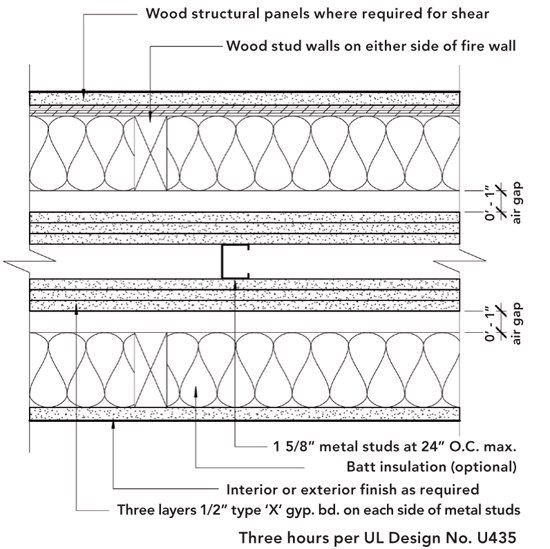
Image: Togawa Smith Martin
Three-hour fire wall assembly
How to Frame with Wood
In addition to selecting the appropriate framing technique, designers of wood buildings must consider factors such as shrinkage, differential movement, and seismic requirements.
Platform Framing and Balloon Framing
There are two common types of framing for wood construction. For Type VA buildings, where exterior walls require a one-hour fire-resistance rating, traditional platform framing is usually used, where the joists sit on top of the double top plates of the wall. Balloon framing is where the joists hang off the ledger that is attached to the structural studs that frame the building. In modified or semi-balloon framing, the floor framing hangs off the double top plates; it is often used as an alternative to platform-framed structures for both Type VA and Type IIIA construction.
Shrinkage
Regardless of the framing type, building designs must compensate for the fact that wood shrinks as it dries. Shrinkage continues until wood reaches its Equilibrium Moisture Content (EMC), which averages 8-12 percent of moisture content for most structures in the U.S. The Western Wood Products Association (www2.wwpa.org) offers a technical guide that includes formulae for calculating shrinkage for different wood species across the country as well as a downloadable shrinkage estimator.
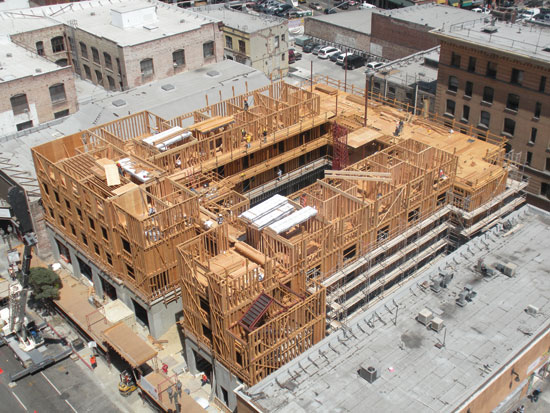
Photo: KC Kim, GB Construction
Built to achieve LEED Platinum certification, New Genesis Apartments in Los Angeles, California, designed by Killefer Flammang Architects, is a mixed-use and mixed-income wood-frame building with commercial retail space.
“Shrinkage calculations aren't complex,” says Kam-Biron, “but it's an area designers aren't always familiar with, and it can be challenging to detail for differential movements between two different materials and overall shrinkage.” The shrinkage effects must be considered for horizontal framing members (width or thickness) in the wall (top/sill plates) and floor (joists) design. Wood is anisotropic, meaning the dimensional change in wood is unequal in different directions. In most softwoods, radial shrinkage (across growth rings) is approximately 4 percent and tangential shrinkage (parallel to growth rings) is approximately 8 percent from green (unseasoned) to typical EMC for structures in the U.S. Longitudinal shrinkage (parallel-to-grain) for vertical framing members is generally negligible and does not affect building performance. Therefore, the majority of shrinkage will occur in the top plates, sill plate and sole plates, and possibly the floor joists—depending on how the floor framing members are framed to the wall. If the framing is balloon-framed or modified balloon-framed, then sawn lumber joists won't play a huge role in overall movement from shrinkage because balloon framing, unlike platform framing, does not accumulate shrinkage over all floors. “Unseasoned (green) sawn lumber will shrink more compared with seasoned (dried) lumber,” says Cheung “Shrinkage should be considered for wood-frame buildings over three stories. The good thing about wood is that it will dry naturally.” Among the many ways to minimize shrinkage is letting the wood dry during construction, or using products and systems such as pre-engineered metal-plate connected wood trusses for floor and/or roof framing, and manufactured wood products (laminated veneer lumber, I-joists, etc.). I-joist floor systems are dimensionally stable and offer minimal inter-floor shrinkage.
Additionally, there can be some overall settlement of the building that may occur due to gaps in the building construction that can contribute to the overall vertical movement. Some contractors will distribute the dead load throughout the height of the building and allow the building to acclimate to the environment and/or air dry prior to installation of the drywall, thus allowing the building to naturally settle.
Differential Movement
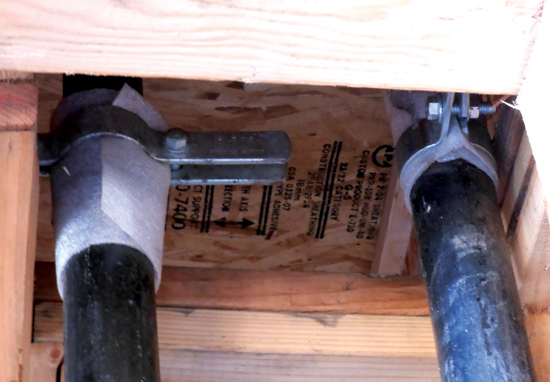
Photo: WoodWorks
Plumbing sleeve connected to structure with foam wrap to allow vertical movement of structure.
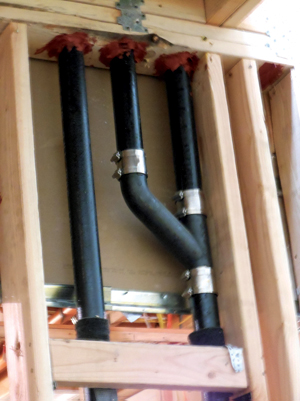
Photo: WoodWorks
Plumbing joints with pipes nested in joint to allow for vertical movement of structure.
Allowing for differential movement between wood and other structural elements and building finishes is critical. Steel, concrete and brick continue to expand and contract due to temperature changes, while wood generally maintains its dimensions having reached its EMC. Differential movement occurs when, for example, floor joists are supported by a wood-frame wall at one end and by the masonry block of an elevator shaft at the other end. Areas such as stairwells, shafts and vaulted ceilings require attention for differential movements as do plumbing, electrical and mechanical systems. Using flexible joints such as flexible pipe, conduit, couplings, elbows, and tees for electrical, mechanical and plumbing between floors can prevent potential problems. The design of the joints between building envelope components, such as windows and doors, must also allow for differential shrinkage.
Seismic Requirements
Earthquakes and rigorous seismic requirements are a well-known aspect of building on the west coast, but other parts of the country, especially in the east, are not immune to earthquake activity and the need to comply with seismic codes. Wood structures offer a high strength-to-weight ratio over those built with steel and concrete (concrete walls are about seven times heavier than typical wood-frame walls) resulting in a low inertia force during earthquakes. In wood-frame buildings, the large number of walls and floors often used in a project transfer lateral loads induced by winds and seismic forces.
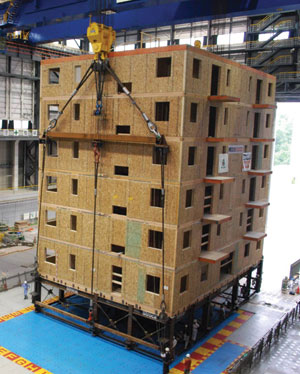
Photo: John Van De Lindt, Univ. Of Alabama
After being lifted to a shake table and subjected to four progressively intense earthquakes, this six-story light-frame building was found to have only minimal damage to the gypsum wallboard and nail connections. (View a video of the test on YouTube.7)
Wood-frame construction also provides numerous load paths through shear walls and diaphragms, which typically have hundreds of structural elements and thousands of nail connections, adding ductility and redundancy to the system. Redundant load paths give additional assurance that loads will be transferred should a connection fail. In contrast, structures supported by heavy non-wood frames have relatively few structural members and connections, meaning fewer load paths. Moreover, the large number of walls reduces the loads shared by each wall. Tests and observations from past earthquakes show that wood buildings have performed well. For example, a six-story light-frame wood building tested on the world's largest shake table in Japan resisted a major 2,500-year earthquake with minimal damage.
Current building code requirements for wood diaphragms, shear walls and holdown devices work effectively in creating earthquake-resistive structures. Horizontal diaphragms in roofs and floors transfer the horizontal forces to the shear walls. Shear walls with holdowns such as a continuous tie-down rod system resist the tension forces in an overturning scenario, while wood studs or columns absorb the compression forces.
In high seismic areas, mid-ply shear walls (i.e., walls with sheathing sandwiched between 2x studs oriented flatwize) have twice the load capacity as traditional shear walls and can be used where increased lateral load capacity is required. This solution would be useful in lower floor lobby areas in multi-story buildings or for stacked corridors and isolated exterior walls.
Innovative Wood Products and Building Systems
A number of innovative technologies and building systems are increasing the opportunities for mid-rise wood buildings. For example:
Prefabricated Systems
Specifying prefabricated or factory manufactured wall and roof panels can provide better quality wall construction since the panels are created off-site in moisture controlled environments. Wall panelizing is particularly useful for jobsites that don't have adequate space to construct the walls and can speed the erection time considerably. Wall panels can also optimize stud design and increase sound proofing and energy efficiency. Panels may range from 4 to 30 feet long, and are lifted into place by crane.
Cross Laminated Timber (CLT)
Cross laminated timber is a multi-layer wood panel in which each layer is oriented crosswise to its adjacent layer for increased dimensional stability and structural performance. Widely used in Europe and now available in North America, it is considered viable for buildings up to 12 stories and even higher.
In Australia, CLT has been used to create a 10-story all-wood building, while eight-story examples exist in the U.K. and Austria. North American applications include (among others) a two-story commercial building in Montana, and a five-story heavy timber/CLT hybrid building at the University of British Columbia.
Among CLT's attractive structural characteristics are high dimensional stability, high axial load capacity, high shear strength, rigidity around openings and negligible settlement effects. CLT assemblies also offer inherent fire resistance due to thick cross-sections that, when exposed to fire, char at a slow and predictable rate, and the ability to resist lateral loads caused by earthquakes or high winds. Other benefits include speed of construction, thermal performance, and the environmental advantages offered by all wood products—including a low carbon footprint.8
Based on recent code change approvals, the 2015 IBC will identify CLT as a structural product and recognize it for use in Type IV exterior walls, floors and roofs. However, while the 2015 IBC won't go into effect in most jurisdictions until 2016, designers can pursue the use of CLT under the alternate means and methods approach in the current code. For more information, APA (www.apawood.org) has developed an American National Standard, ANSI/APA PRG 320 2011: Standard for Performance Rated Cross-Laminated Timber.
Conclusion
The last few years have seen a trend toward taller wood buildings, driven by their acceptance in building codes and the value they provide. Design professionals are capitalizing on wood's ability to offer high density at less cost than other materials. They also appreciate wood's versatility, adaptability and light carbon footprint. However, while today's building codes recognize wood's safety and performance capabilities in buildings that are five and six stories—and these are becoming increasingly common—innovative technologies such as CLT can be expected to propel designers of mid-rise wood buildings to even greater heights.
Endnotes
- Life Cycle Environmental Performance of Renewable Building Materials in the Context of Building Construction, Consortium for Research on Renewable Industrial Materials, Phase I 2005, Phase II 2010; A Synthesis of Research on Wood Products and Greenhouse Gas Impacts, Sarthre, R. and J. O'Connor, 2010, FPInnovations; Werner, F. and Richter, K. 2007, Wooden building products in comparative LCA: A literature review, International Journal of Life Cycle Assessment
- See endnote 1.
- The carbon calculator was developed by FPInnovations, WoodWorks and the Canadian Wood Council; available at www.woodworks.org
- Case study, http://woodworks.org/wp-content/uploads/Stella-CaseStudy-WEB.pdf
- O'Connor, J., 2004, Survey on Actual Service Lives for North American Buildings, FPInnovations
- Case study: All-wood Podiums in Midrise Construction, APA, www.apawood.org/level_c.cfm?content=pub_searchresults&pK=wood%20podium&pT=Yes&
pD=Yes&pF=Yes&pubGroup=
- www.youtube.com/watch?v=c25HuZeQsyo&context=C3f612acADOEgsToPDskLH3EQs-aodM9-NsZgF2lGi
- U.S. CLT Handbook,www.masstimber.com/products/cross-laminated-timber-clt/handbook
 |
The reThink Wood initiative is a coalition of interests representing North America's wood products industry and related stakeholders. We share a passion in wood and the forests they come from. Innovative new technologies and building systems have enabled longer wood spans, taller walls and higher buildings, and continue to expand the possibilities for wood use in construction. www.rethinkwood.com |
 |
WoodWorks is an initiative of the Wood Products Council established to provide free one-on-one project support, education and resources related to the design of non-residential and multi-family wood buildings. If you have a project that requires technical expertise in wood design, contact help@woodworks.org. www.woodworks.org
|


